“The Galaxy M10 feels incredibly light in the hand as the phone’s body is primarily made out of plastic”
It has been some time since Samsung last introduced a new smartphone series, but to start off 2019 with a defining statement, the South Korean brand has now unveiled not one, but two handsets from its brand new ‘Galaxy M‘ range. In this review, we’ll be going over the more affordable variant out of the two – the Galaxy M10, and let you know whether the company is ready to take on the likes of Xiaomi and Realme in this price range or not.
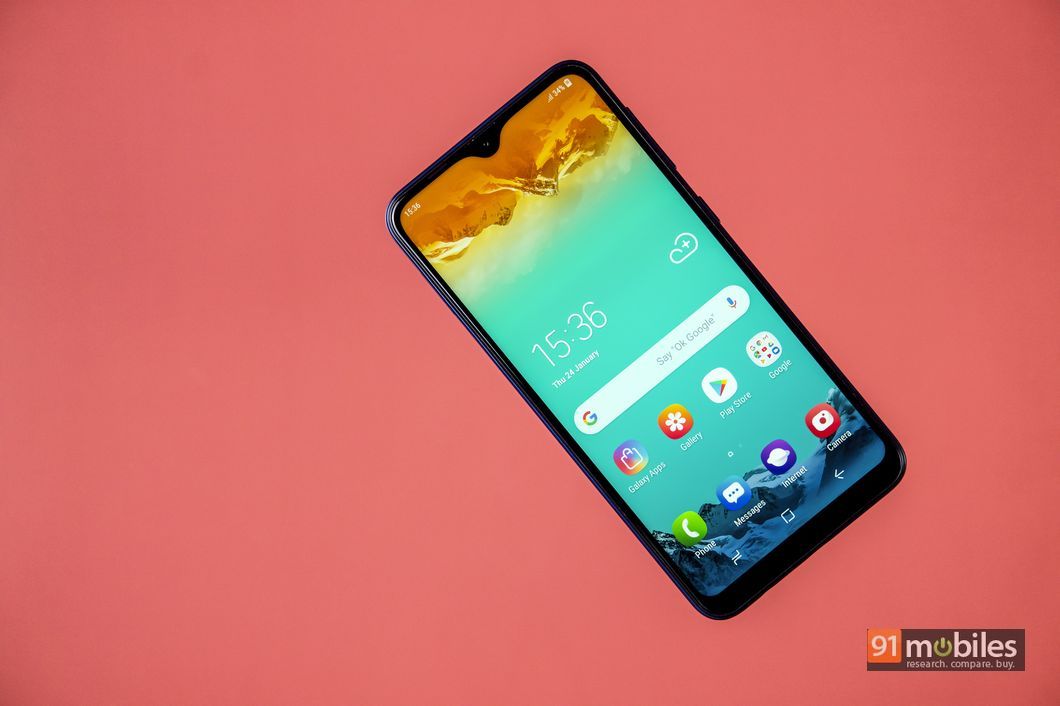
Table of Contents
Design and display
Just two years ago, we would have been extremely liberal with our evaluation of a smartphone’s design in the budget price bracket. However, handsets launched in the affordable price range last year raised the bar for this category. Coming to the Galaxy M10, one of the key design highlights is the fact that it utilises an Infiniti V display, which is Samsung’s term for a waterdrop notch. The brand seems to have skipped the notch display bandwagon entirely, and directly jumped onto this latest fad. The phone’s body is primarily made out of plastic, which looks good but does attract a few scuffs after regular use. We liked the build quality of the phone and can vouch for the fact that it does not look cheap.
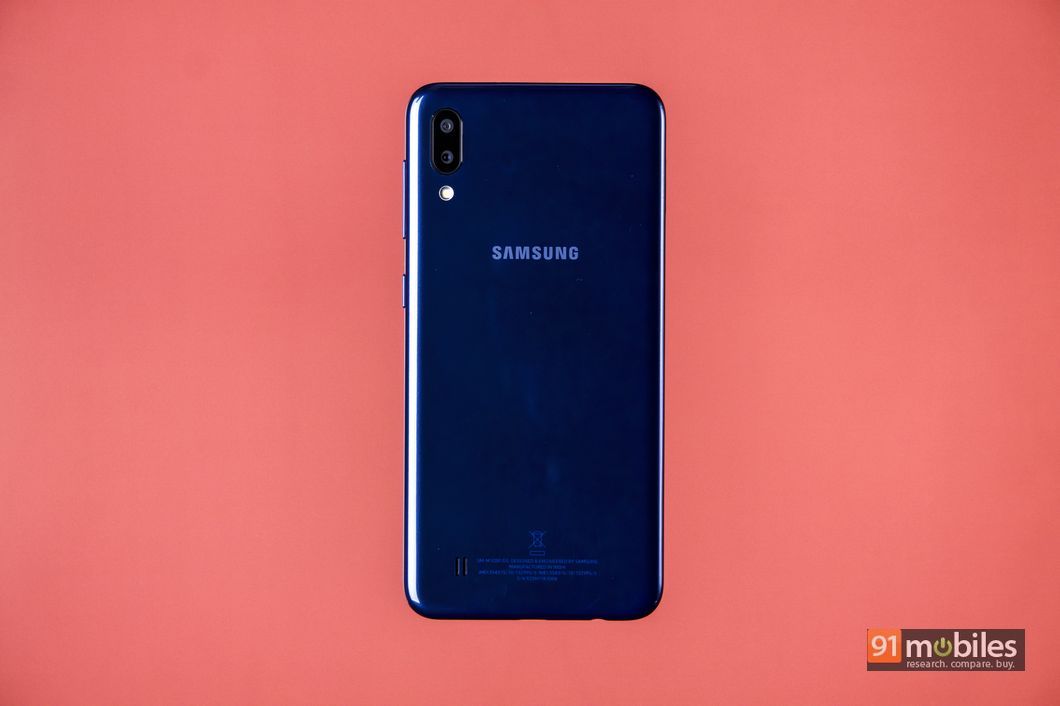
The most notable difference as compared to the M20 is that the back of the Galaxy M10 does not feature a fingerprint sensor. Now, admittedly, the lack of a fingerprint sensor might prove to be a dealbreaker for some users but to compensate for this, the brand is offering a face unlock feature. We will discuss the performance of this security feature in detail later on.
 Going with a look reminiscent of ASUS ZenFone Max Pro M2 (review), the Galaxy M10 sports a dual camera module at the back that is located on the top left in a vertical orientation, with an LED light right below to assist in low-light conditions. The phone’s frame is fairly thin and houses the volume rocker and the power button on the right side.
Going with a look reminiscent of ASUS ZenFone Max Pro M2 (review), the Galaxy M10 sports a dual camera module at the back that is located on the top left in a vertical orientation, with an LED light right below to assist in low-light conditions. The phone’s frame is fairly thin and houses the volume rocker and the power button on the right side.
 At the bottom of the phone, you will find the audio jack and the micro-USB charging port. The SIM card slot is located on the left. The Galaxy M10 comes with a triple slot tray that has a dedicated slot for the microSD card.
At the bottom of the phone, you will find the audio jack and the micro-USB charging port. The SIM card slot is located on the left. The Galaxy M10 comes with a triple slot tray that has a dedicated slot for the microSD card.
 Without wasting any more time, let’s discuss the display on Galaxy M10. The Galaxy M10, just like its sibling, comes with an Infinity-V notch design that is not much different than the waterdrop notch found on several other Android handsets. The bottom bezel, however, is reasonably thick. In between the top and the bottom bezel, you will find a 6.22-inch HD+ display that looks vibrant from the word go. Regarding the notch design, we have come to a point where most phones feature some kind of notch. If you have an issue with this design choice, you can choose the ‘Hide camera‘ option from Full Screen Apps section in the settings.
Without wasting any more time, let’s discuss the display on Galaxy M10. The Galaxy M10, just like its sibling, comes with an Infinity-V notch design that is not much different than the waterdrop notch found on several other Android handsets. The bottom bezel, however, is reasonably thick. In between the top and the bottom bezel, you will find a 6.22-inch HD+ display that looks vibrant from the word go. Regarding the notch design, we have come to a point where most phones feature some kind of notch. If you have an issue with this design choice, you can choose the ‘Hide camera‘ option from Full Screen Apps section in the settings.
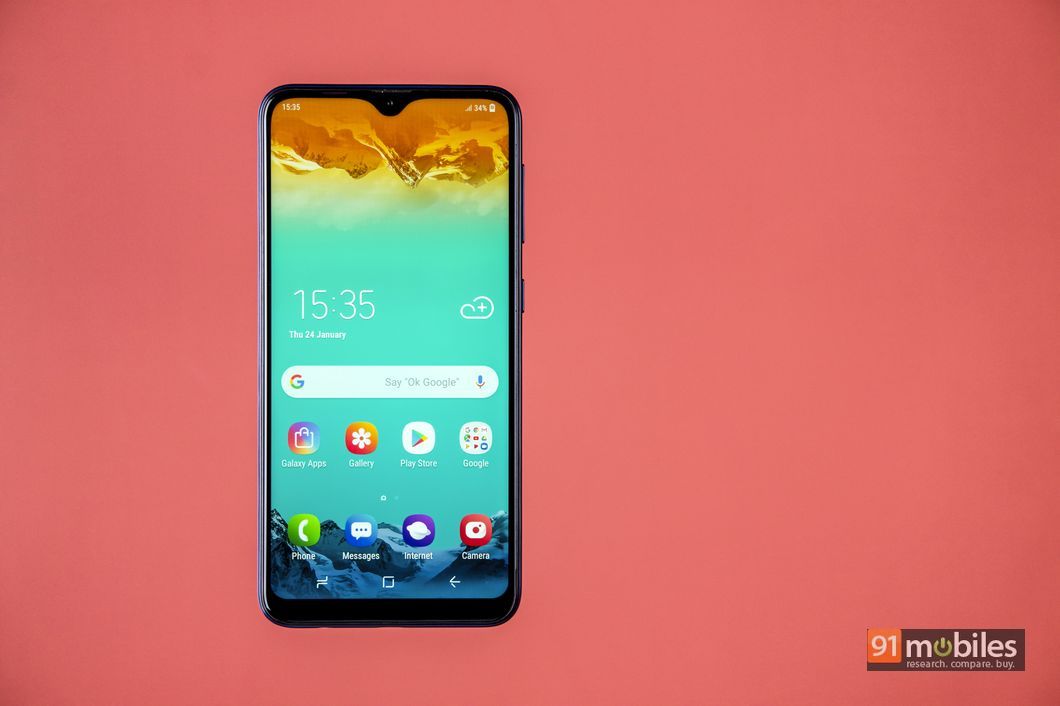 If we talk about the display quality specifically, despite being low on resolution, the panel didn’t disappoint us at all. The text appeared crisp and colours popped out in most use cases. Even the maximum screen brightness was decent enough for outdoor use. The slim bezels provided for an all-around immersive viewing experience. Here’s a closer look at the phone.
If we talk about the display quality specifically, despite being low on resolution, the panel didn’t disappoint us at all. The text appeared crisp and colours popped out in most use cases. Even the maximum screen brightness was decent enough for outdoor use. The slim bezels provided for an all-around immersive viewing experience. Here’s a closer look at the phone.
Cameras
The Samsung Galaxy M10 comes with a dual camera setup at the back, consisting of a primary 13MP snapper with f/1.9 aperture and a wide-angle 5MP sensor with f/2.2 aperture. At the front, the phone packs an 8MP unit for clicking selfies and video-calling. Before we dive into the camera performance, we’d like to give you a brief overview of the default camera app. Here, you get the option to click pictures in either regular mode or the wide-angle mode.



Samsung has also included the Live Focus mode, which essentially lets you click pictures with bokeh effect. It should be kept in mind that this mode only works for human subjects, when the phone is able to recognise a face in the frame. The Galaxy M10 struggles to detect the outlines well but gets the work done on most occasions. You can also choose to click pictures in Panorama, with stickers, or in beauty mode. If you like to adjust the ISO level and white balance before clicking pictures, there is a Pro mode that will let you do just that.



The Samsung Mall app is also integrated into the camera app and users can either click pictures of the product they want to search and purchase, or choose an image from the gallery to start shopping. After using this feature for some time, we can say that slightly distinctive products definitely produce good search results but in many cases, the app is not able to recognise the brands and the specific products reliably.
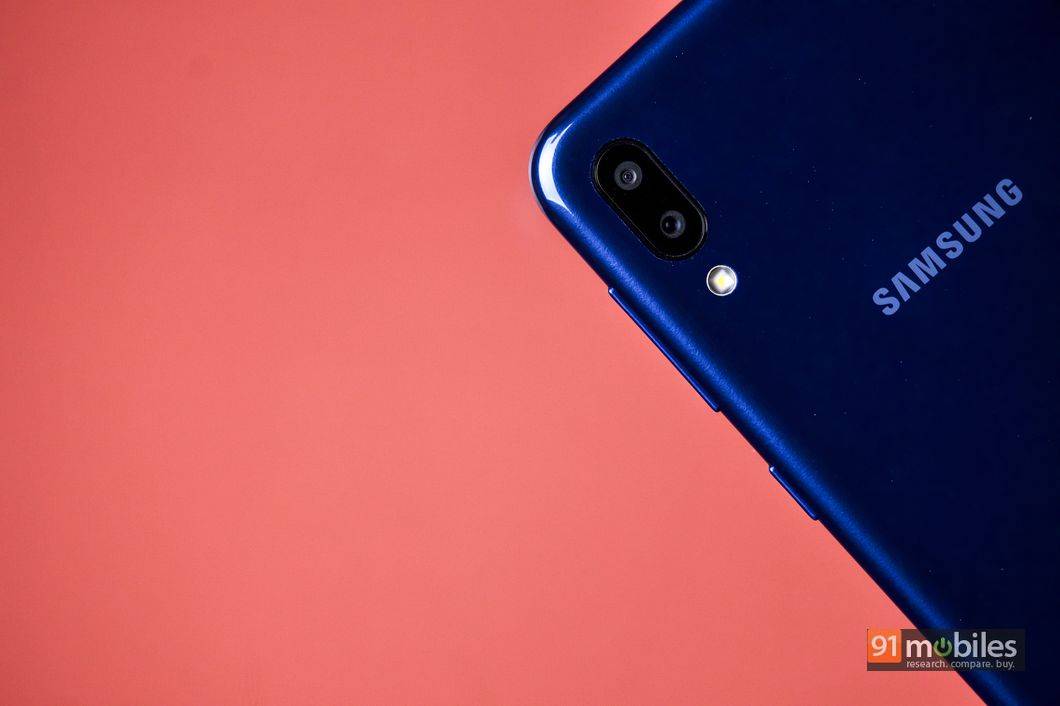 Moving to the camera performance, we tried out the Galaxy M10’s snappers in different kinds of settings to understand the sensors better. Now, the dual camera setup on the phone manages to capture details very well and helped us take some good shots. Unfortunately, the dynamic range offered by the camera module is not all that great. There is a notable difference between the images taken with HDR switched on and off, as you can see from the floor in the restaurant image in the camera samples gallery embedded below. However, there was a visible fisheye effect in the images taken with the wide-angle mode. We would have appreciated if the phone would have handled the wide-angle images somewhat like the Galaxy A7 (2018) (review), which showed a very subtle fisheye effect, but sadly, that was not the case.
Moving to the camera performance, we tried out the Galaxy M10’s snappers in different kinds of settings to understand the sensors better. Now, the dual camera setup on the phone manages to capture details very well and helped us take some good shots. Unfortunately, the dynamic range offered by the camera module is not all that great. There is a notable difference between the images taken with HDR switched on and off, as you can see from the floor in the restaurant image in the camera samples gallery embedded below. However, there was a visible fisheye effect in the images taken with the wide-angle mode. We would have appreciated if the phone would have handled the wide-angle images somewhat like the Galaxy A7 (2018) (review), which showed a very subtle fisheye effect, but sadly, that was not the case.
If we talk about the images taken in low-light conditions, the pictures turned out to be grainy. But on the positive side, the images taken by Galaxy M10 in low-light conditions were better than most of the other handsets in this price range. The phone lets you shoot videos in up to 1080p resolution and the quality of these videos is not bad either.The selfie camera on the Galaxy M10 manages to take some detailed pictures but we did not find it to be quite as impressive as the one found on the Realme 2 (review) and the Xiaomi Redmi Note 5 (review).
Hardware and Software
The Galaxy M10 is powered by the brand’s octa-core Exynos 7870 chipset, clocked at 1.6GHz. There are two configurations available for the handset, i.e. 2GB RAM with 16GB storage, and 3GB RAM with 32GB storage, our review unit being the latter. The onboard storage is expandable up to 512GB via a microSD card. Now that we have got the specifications aside, let’s talk about the real-world performance. In the time that we spent with the Galaxy M10, we did not face any stutter or lag issues while switching between the apps or navigating through the user interface. For a budget phone from Samsung, this is an impressive feat.
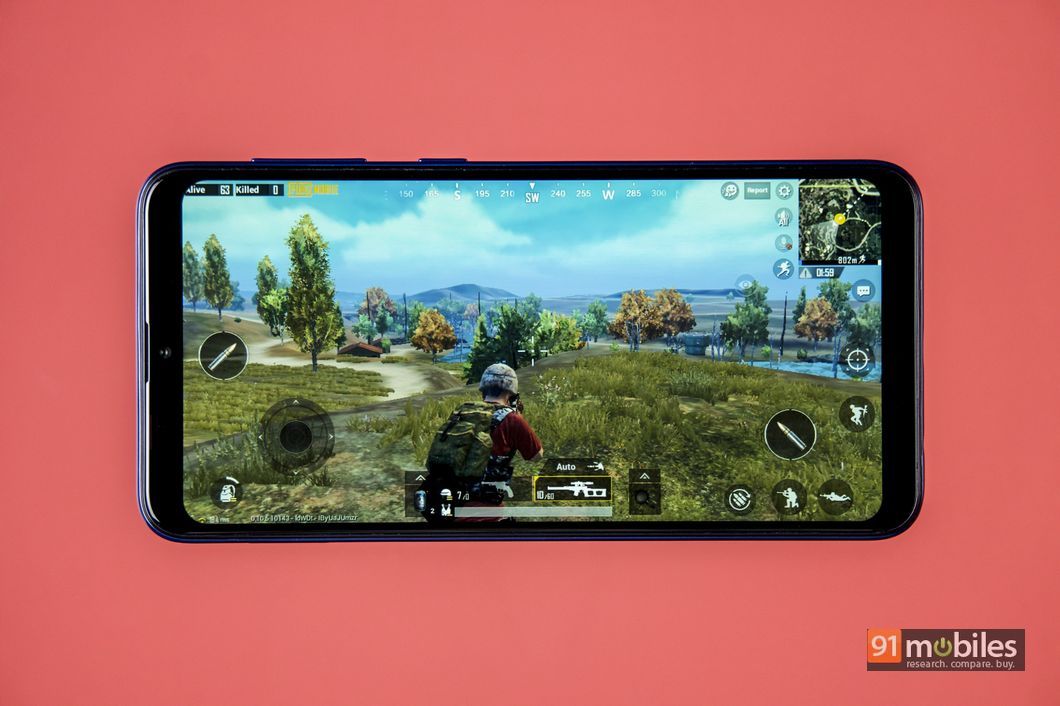 As we do with most phones, irrespective of the price range, we played PUBG Mobile on the phone to figure out how it deals with the graphically demanding game. By default, the game suggested low graphics settings for the phone, which was hardly a surprise. To be fair, we had realistic expectations from the phone before jumping into the game as this handset does not primarily cater to the gaming audience. We faced some stutter issues within the game but we can still say that it was largely playable. To put it simply, if you just want to play a casual game of PUBG Mobile, you won’t be disheartened with the performance offered by the Galaxy M10, but you should look for other options in case you like gaming on your phone.
As we do with most phones, irrespective of the price range, we played PUBG Mobile on the phone to figure out how it deals with the graphically demanding game. By default, the game suggested low graphics settings for the phone, which was hardly a surprise. To be fair, we had realistic expectations from the phone before jumping into the game as this handset does not primarily cater to the gaming audience. We faced some stutter issues within the game but we can still say that it was largely playable. To put it simply, if you just want to play a casual game of PUBG Mobile, you won’t be disheartened with the performance offered by the Galaxy M10, but you should look for other options in case you like gaming on your phone.
App loading times, in general, are not particularly impressive but in this price range, this will be considered nitpicking. We should mention, however, that we were especially disappointed with the loudspeaker performance offered by the handset.
Having discussed the hardware, it is time to throw some light on the software that drives the Galaxy M10. If you were expecting the phone to load Samsung’s One UI, we should inform you right away that it is not the case. The Galaxy M10 runs Android 8.1 Oreo-based Experience 9.5 user interface out of the box. Samsung has undoubtedly come a long way in the last few years in decluttering its platform and its Experience UI is closer to the stock Android interface than ever before.
 This means that you can access the app drawer by simply swiping either downwards or upwards from the home screen, use multi-window feature by tapping the option from the recent apps and hold an icon to get access to quick actions. Samsung still has some new and old features up its sleeves to make sure that the interface has something additional to offer over the stock UI. For example, the ‘Lock Screen Stories‘ feature allows users to discover new stories every single time they pick up their phone. We found that as we had the face unlock option enabled, this feature was a little blink and miss for us… but a dynamic lock screen is an interesting idea nevertheless. Additionally, users can also choose the categories for these stories in case they want to see stories of a particular genre.
This means that you can access the app drawer by simply swiping either downwards or upwards from the home screen, use multi-window feature by tapping the option from the recent apps and hold an icon to get access to quick actions. Samsung still has some new and old features up its sleeves to make sure that the interface has something additional to offer over the stock UI. For example, the ‘Lock Screen Stories‘ feature allows users to discover new stories every single time they pick up their phone. We found that as we had the face unlock option enabled, this feature was a little blink and miss for us… but a dynamic lock screen is an interesting idea nevertheless. Additionally, users can also choose the categories for these stories in case they want to see stories of a particular genre.



Then there are some pre-installed apps from Microsoft, Google, and of course Samsung. The Game Launcher feature, as you might already know, serves to improve your gaming performance by hiding notification banners and allocating phone’s resources to gaming, in case you choose to do so. Coming to the face unlock feature that we mentioned briefly in the design section, the unlocking method worked just fine for us. However, it takes slightly more than a second to unlock, which is not bad but slower than some other phones in the market. There is also a nice animation effect around the notch area as soon as you unlock the phone.
Overall, there are just a handful of pre-installed apps and all of them can either be disabled or uninstalled. The clean interface definitely looks promising and should work well in the long run.
Battery
Compared to the Galaxy M20, which houses a massive 5,000mAh battery, the Galaxy M10 uses a smaller, 3,400mAh cell. So how does this translate into real-world usage?

To put things into perspective, the M10 managed to last for around a day in regular use, which is not bad. In our HD video loop test, the Galaxy M10 lasted for around 17 hours, which should be enough for most users.
Verdict
Samsung has not launched a lot of affordable phones in the recent past, and Galaxy M10 looks like a solid entry in the market below the Rs 10,000 mark. The phone offers a good display, decent camera performance, and a satisfactory battery backup, which are some of the most appealing features for any potential customer. However, the Galaxy M10 will be going up against the likes of Realme 2 (review) and the Xiaomi Redmi 6 (review), both of which are also compelling offerings in this price range. Despite some minor issues, we can say that the Galaxy M10 gets a thumbs up from our side, and is worth a look for brand-conscious buyers.
Editor’s rating: 3.5 / 5
Pros
- Minimalistic design
- Good display quality
- Decent battery backup
Cons
- Lacks fingerprint sensor
- Loudspeaker performance is average
Photos by Raj Rout
 Samsung Galaxy M10 Samsung Galaxy M10 | vs |  Asus Zenfone Max Pro M1 Asus Zenfone Max Pro M1 |
 Samsung Galaxy M10 Samsung Galaxy M10 | vs |  realme 2 realme 2 |




























